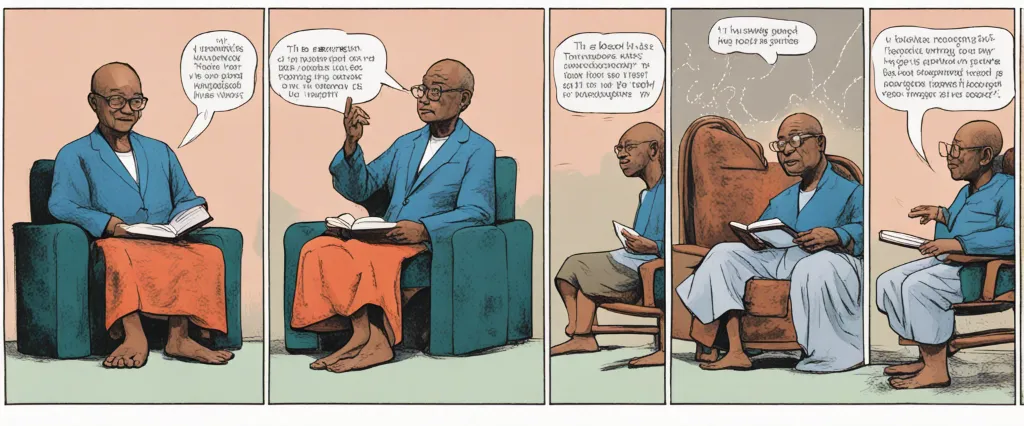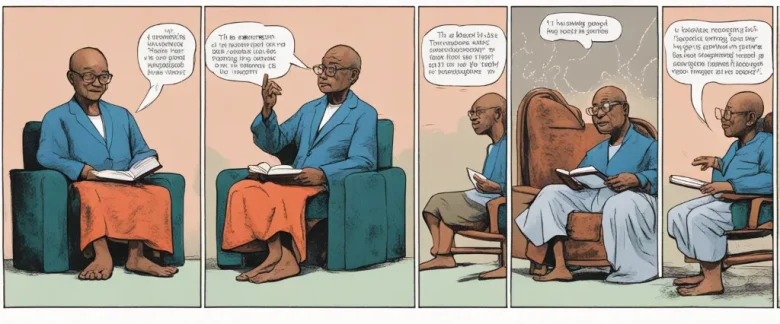
In “The Book of Forgiving,” renowned South African cleric Archbishop Desmond M. Tutu, together with his daughter Reverend Mpho Tutu, offers profound insights into the transformative power of forgiveness. Drawing from his personal experiences as a crucial figure in the fight against apartheid and his role as Chairman of the Truth and Reconciliation Commission, Archbishop Tutu delves into the depths of human suffering and the remarkable capacity for healing through forgiveness. Aimed at guiding individuals on a path towards personal freedom and societal reconciliation, this powerful book imparts timeless and essential wisdom on forgiveness.
Chapter 1: The Power of Forgiveness
Chapter 1 of “The Book of Forgiving” by Desmond M. Tutu explores the profound power forgiveness holds and how it can transform our lives. Tutu emphasizes that forgiveness is not meant to absolve the wrongdoer or justify their actions; rather, it is a healing process for the one who forgives.
Tutu begins by sharing his personal experiences of forgiveness in the aftermath of apartheid in South Africa. He highlights that forgiveness is not easy, especially in situations where the wounds run deep, but it is essential for our well-being. Tutu acknowledges the pain and anger that accompanies transgressions but explains that forgiveness is crucial for breaking free from the cycle of revenge and hatred.
The author introduces four critical components of forgiveness: Telling the Story, Naming the Hurt, Granting Forgiveness, and Renewing or Releasing the Relationship. Tutu asserts that telling our stories and acknowledging the pain we have experienced can help us to process and heal from the hurt. By naming the hurt, we confront the emotions linked to the wrongdoing, allowing us to release them.
Forgiveness, Tutu explains, is not a unilateral decision; it involves both the wrongdoer and the victim. The act of granting forgiveness is an intentional and conscious choice, freeing us from the chains that keep us locked in anger and resentment.
Lastly, Tutu emphasizes that forgiveness is not just a one-time act but a continuous, transformative journey. By renewing or releasing the relationship, individuals can move forward, potentially rebuilding trust and fostering reconciliation.
Overall, Chapter 1 of the book emphasizes the power of forgiveness and its healing potential. Tutu shows that forgiveness is a necessary step in addressing and overcoming the pain caused by wrongdoing, ultimately leading to personal freedom and reconciliation.
Chapter 2: The Truth about Hurt
Chapter 2 of the book “The Book of Forgiving” by Desmond M. Tutu, titled “The Truth about Hurt,” delves into the deeply painful experiences of hurt and the lasting impact it has on individuals and communities. Tutu explains that hurt is an inevitable part of the human experience, and it affects us both emotionally and physically, causing immeasurable suffering.
Tutu emphasizes the need to acknowledge and face the truth about the hurt we have experienced. He highlights that hurt is not something to be buried or ignored but rather confronted and processed. Tutu explains that facing the truth requires honesty and courage to examine the pain and accept its reality. Only by acknowledging the hurt can we begin the journey towards forgiveness.
Furthermore, Tutu discusses the cycle of victimhood and how it perpetuates the cycle of hurt. The victims often become perpetrators themselves, passing on the pain they have endured. Tutu reminds the readers that understanding this cycle is crucial for breaking its hold on us and breaking free from resentment and bitterness. He suggests that forgiveness is the antidote to this cycle, as it liberates both the victim and the perpetrator from the bondage of hurt.
Throughout the chapter, Tutu emphasizes that hurt cannot be repressed, and it thrives in secrecy. He encourages individuals to open up and share their pain with trusted individuals or through therapeutic means, as this can grant relief and offer the potential for healing. Tutu also stresses the importance of empathy and compassion in the healing process, as understanding the pain of others helps in cultivating forgiveness.
In Chapter 2 of “The Book of Forgiving,” Tutu underscores the significance of acknowledging and confronting the truth about hurt, and he sets the stage for the exploration of forgiveness as the path towards healing and liberation from the cycle of pain.
Chapter 3: The Fourfold Path of Forgiveness
Chapter 3 of “The Book of Forgiving” by Desmond M. Tutu, titled “The Fourfold Path of Forgiveness,” explores a systematic approach to forgiveness that can guide individuals towards healing and transformation. Tutu suggests that forgiveness involves four major steps, each crucial in the process of letting go of anger, resentment, and pain in order to find peace.
The first step in the Fourfold Path is Telling the Story. Tutu emphasizes the importance of acknowledging and expressing the pain caused by the offense. This involves recounting the story of the hurt, allowing all the emotions associated with it to surface, and not suppressing or minimizing one’s feelings.
The second step is Naming the Hurt. In this stage, individuals are encouraged to explore and articulate the specific ways they have been harmed. By labeling and confronting the hurt, people can better understand its impact on their lives and begin the process of healing.
The third step, Granting Forgiveness, involves letting go of the desire for revenge or punishment and releasing the hold that the offense has on one’s life. Tutu notes that forgiveness is not about forgetting or condoning, but rather about freeing oneself from the negative emotions associated with the harm.
The final step is Renewing or Releasing the Relationship. This step explores the possibility of rebuilding the relationship or choosing to move on without holding onto resentment. Tutu emphasizes that forgiving does not necessarily mean reconciling, as trust may not be fully restored, but it allows for the opportunity to find healing and ultimately create a new relationship.
By following the Fourfold Path of Telling the Story, Naming the Hurt, Granting Forgiveness, and Renewing or Releasing the Relationship, individuals can embark on a journey of forgiveness and find profound healing, healing that goes beyond themselves and enables a more peaceful and compassionate world.
Chapter 4: The Obstacles to Forgiveness
Chapter 8: The Practice of Forgiveness
Chapter 8 of “The Book of Forgiving” by Desmond M. Tutu is titled “The Practice of Forgiveness.” This chapter delves into the practical aspects of forgiveness and offers guidance on how to cultivate a forgiving heart.
Tutu begins by explaining that forgiveness is a choice rather than a feeling. It is an active process that requires intention and effort. He emphasizes that forgiveness does not mean condoning or forgetting the harm done; rather, it is about freeing oneself from the burden of hatred and resentment.
One significant aspect of practicing forgiveness is recognizing the humanity in both the offender and the victim. Tutu highlights the importance of acknowledging the shared flawed nature of all individuals, allowing compassion to bloom. By realizing that people make mistakes and are capable of change, forgiveness becomes more achievable.
The author also emphasizes the significance of storytelling and communication as tools for healing and forgiveness. Sharing one’s story can lead to understanding, empathy, and the breaking down of barriers. Tutu encourages victims to find safe spaces to share their pain and for offenders to take responsibility and express remorse.
Furthermore, Tutu discusses the power of apology in the forgiveness process. An authentic apology is not merely saying sorry; it involves sincere remorse, taking responsibility, making amends, and seeking reconciliation.
Tutu suggests practical exercises to foster forgiveness. These include writing letters (even unsent ones) to express feelings, creating rituals of forgiveness, and engaging in meditation or prayer practices that focus on forgiveness. These exercises help individuals move towards healing and granting forgiveness.
In summary, Chapter 8 focuses on the practical aspects of forgiveness. Tutu highlights the importance of choice, compassion, communication, and storytelling in the journey towards forgiveness. The chapter provides practical tools and exercises to guide individuals in developing a forgiving heart and finding peace.
After Reading
In “The Book of Forgiving,” Desmond M. Tutu delivers a profound exploration of the transformative power of forgiveness. With heartfelt anecdotes and wisdom, Tutu invites readers on a journey to understand the complexities of forgiving others and ourselves. He emphasizes that forgiving does not mean forgetting or condoning, but rather a conscious choice to let go of anger and resentment. Tutu skillfully delves into the healing process, guiding us to embrace compassion and empathy as we navigate the path of forgiving. Ultimately, he reminds us that forgiveness is not only an individual act, but a potential catalyst for societal healing and reconciliation. This book serves as a powerful reminder that forgiveness is not only possible but necessary for personal growth and collective harmony.



